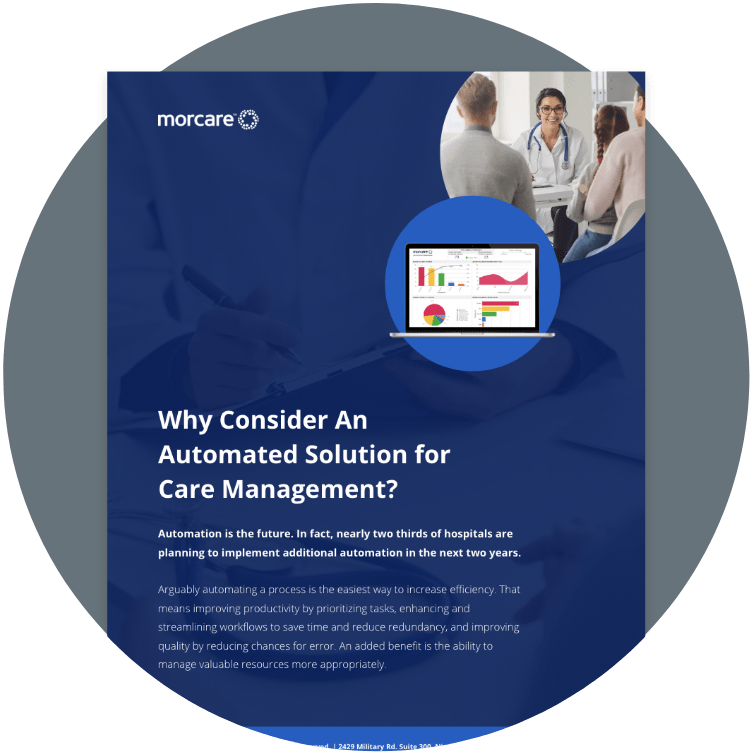Download your copy of this complimentary information piece on structured interdisciplinary bedside rounds:
Bedside rounds have fallen in and out of favor over the years, but more recently have become increasingly popular. Recognized as a tool for improving efficiency and communication, they have been endorsed by the Institute for Healthcare Improvement (IHI) (www.ihi.org) and The Joint Commission (TJC) (www.jointcommission.org). They are also an effective and efficient tool for hospital case managers to use to gather information on their patients and to hear the plans of the other members of the interdisciplinary care team.
Why Bedside Rounds?
- Walking rounds, or bedside rounds, enable all members of the healthcare team who are caring for a specific patient, to offer their individual expertise and make informed contributions to the care of that patient. During bedside rounds all the various disciplines are able to come together to better coordinate the patient’s care. Bedside rounds also improve communication among and between the team members. The Institute for Healthcare Improvement (IHI) and the Joint Commission both consider bedside rounds as best practice. According to the Center for Patient Safety Standardizing work is one of the best ways to reduce errors. www.centerforpatientsafety.org.
- In addition, structured interdisciplinary bedside rounds are a critical element of patient flow. They are a tool for identifying delays in patient care processes as they are happening and take action to correct them using the resources of the entire care team. Bedside rounds are not change of shift report.
- They are an interdisciplinary care planning tool where expected outcomes of care, barriers to care, care transitions and discharge information can be shared among the team members.
The Focus for Rounds
- There are several elements to focus on for bedside rounds. During rounds each of these elements should be focused on as part of the “talking points”. We will discuss more on the talking points later. The elements listed below can be used to support your hospital’s rounds talking points.
- Coordination of care:This component is key to the walking rounds process. Coordination of care should begin with a review of the patient’s current status with input from each team member. This should be followed by a discussion and clarification of the patient’s goals and expected outcomes of care. Finally, a comprehensive plan of care should be developed or modified as appropriate.
- Communication:Rounds is the best time to discuss any issues associated with patient safety, patient education, and daily goals. By communicating together as a team, the group can be better assured that a consistent approach will be used by all the team members.
Key Components to Consider When Developing Rounds
- These steps, while not necessarily linear, are essential elements for the development of the rounding process.
- Identify and refine your goals for rounds: The rounds development team should determine that the purpose is for rounding in your organization and reach consensus from the group as to what the goals of rounding will be. The goals should be consistent through-out the organization regardless of the unit or specialty service.
- Create a structure and stick to it: The rounds development team should define the structure for rounds prior to implementation. This structure should be consistent through-out the organization so that whatever unit is rounding should have a similar process.
- Identify the leader of rounds: The leader should be identified by discipline or job title. This might be a physician, hospitalist, nurse manager or case manager for example. Whenever possible, the leader should be consistent regardless of unit or specialty. A back-up to the leader should also be identified.
- Pick a standard time for rounds each day: A time should be selected that is mandatory and applied consistently on every unit. The only exception to this might be the critical care units.
- Engage with the patient and the family: A mechanism for including the patient and family in rounds should also be established. This might include discussions with them at the bedside and additional patient care conferences as needed.
- Measure success: Before beginning your organization-wide rounds, have the rounds development team identify the ways in which you might measure the success of your rounding process. Collect pre-implementation data before you begin.
Who Should Attend Rounds?
There is a minimum list of disciplines that should be attending rounds and others can be added as needed. With the patient at the center, recommended team members should include the staff nurse caring for the patient, the hospitalist or physician of record and the case manager. Additional disciplines can be added as needed. Additional team members will be dependent on the specialty of the nursing unit. For example, if the unit specializes in orthopedics, then it would be recommended that a physical therapist be included in rounds. On a geriatric unit a nutritionist might be a good addition. At a minimum, be sure that the team members selected represent all relevant disciplines. Some may need to be added on an ad hoc basis as well.
Strategies for Getting Started
A good first step is to leverage your existing rounds processes. It is possible that some of your nursing units already conduct some form of a rounding process. This may be in a conference room or bedside. Conduct as assessment of the current rounds on the units that have them and compile a spreadsheet outlining the similarities and differences between them. Some of the existing rounds may already be in the format that the rounds planning committee has established and will need little to no revision or change. Others may be totally off the mark and need complete revision to their existing processes.
The next step would be to seek out one or two nursing units that are willing to participate. Willing participants increase the likelihood that you will be successful with the first units that are implemented. Start small, by implementing on or two units first. In this way you can identify any issues that may need to be adjusted or corrected and make those corrections before you go any further.
Start by educating the team members as to the goals of the rounds and the processes. Segment the processes so that team members can gradually embrace the elements of the rounding process.
The rounds planning team should develop a daily documentation tool that can be placed in the electronic medical record and be used to document the attendees of rounds and the outcomes. Each patient should have a daily goal documented and agreed on by the interdisciplinary team. Track interventions and patient outcomes against these goals on rounds each day and get feedback from each team member caring for the patient.
Scheduling the rounds by nursing beds is a good way to frame the structure. Identify the beds assigned to each staff nurse and cohort the beds accordingly. If you need to round with a specialty physician, then focus on those patients with that physician.
Scripting
Scripting, or developing ‘talking points’ for the team can increase the likelihood that the rounds will be kept to the key elements and not take too long. Standardize the key questions that the team wants to answer as well as the questions that the team wants to address with the patient and family. Write them on the goal sheet or some other tool. Use the scripting as a means of keeping the discussion of each patient to sixty seconds on the average. Remind the team to keep academic discussion related to anatomy and pathophysiology, medications or similar issues out of the patient’s room unless the patient specifically asks to be included in these discussions.
Part of the scripting should include what will be said to the patient as well as how to manage the patient and family’s expectations. Be sure to include something about addressing patient questions that may require more time. Let the patient know that someone will come back after the rounds are completed to address their questions. Also plan to have support staff trained to bring the patients water, tissues or other such items if they ask for them during rounds.
Interested in learning more? Please contact us.

